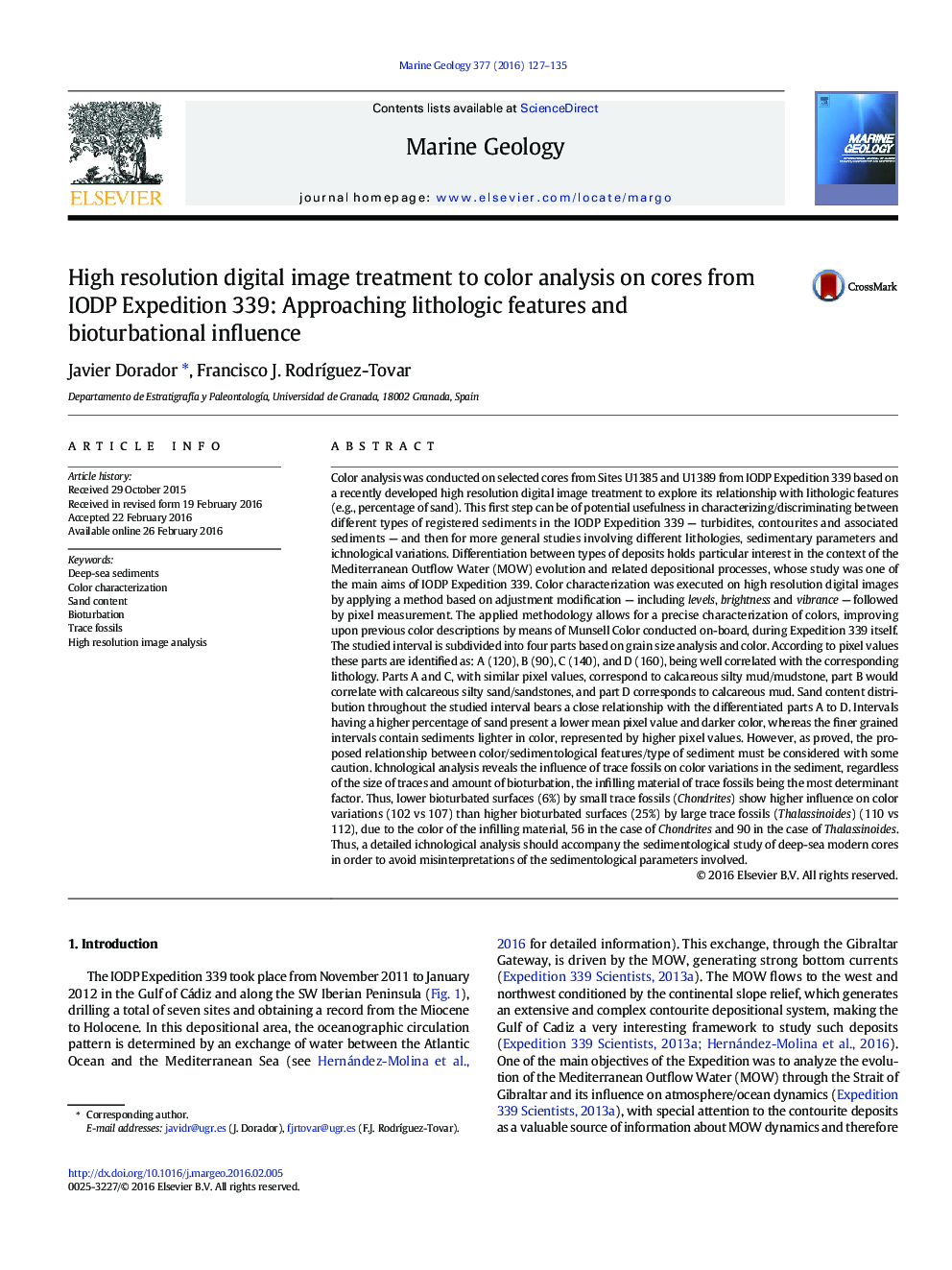| کد مقاله | کد نشریه | سال انتشار | مقاله انگلیسی | نسخه تمام متن |
|---|---|---|---|---|
| 6441339 | 1639075 | 2016 | 9 صفحه PDF | دانلود رایگان |
عنوان انگلیسی مقاله ISI
High resolution digital image treatment to color analysis on cores from IODP Expedition 339: Approaching lithologic features and bioturbational influence
دانلود مقاله + سفارش ترجمه
دانلود مقاله ISI انگلیسی
رایگان برای ایرانیان
کلمات کلیدی
موضوعات مرتبط
مهندسی و علوم پایه
علوم زمین و سیارات
ژئوشیمی و پترولوژی
پیش نمایش صفحه اول مقاله

چکیده انگلیسی
Color analysis was conducted on selected cores from Sites U1385 and U1389 from IODP Expedition 339 based on a recently developed high resolution digital image treatment to explore its relationship with lithologic features (e.g., percentage of sand). This first step can be of potential usefulness in characterizing/discriminating between different types of registered sediments in the IODP Expedition 339 - turbidites, contourites and associated sediments - and then for more general studies involving different lithologies, sedimentary parameters and ichnological variations. Differentiation between types of deposits holds particular interest in the context of the Mediterranean Outflow Water (MOW) evolution and related depositional processes, whose study was one of the main aims of IODP Expedition 339. Color characterization was executed on high resolution digital images by applying a method based on adjustment modification - including levels, brightness and vibrance - followed by pixel measurement. The applied methodology allows for a precise characterization of colors, improving upon previous color descriptions by means of Munsell Color conducted on-board, during Expedition 339 itself. The studied interval is subdivided into four parts based on grain size analysis and color. According to pixel values these parts are identified as: A (120), B (90), C (140), and D (160), being well correlated with the corresponding lithology. Parts A and C, with similar pixel values, correspond to calcareous silty mud/mudstone, part B would correlate with calcareous silty sand/sandstones, and part D corresponds to calcareous mud. Sand content distribution throughout the studied interval bears a close relationship with the differentiated parts A to D. Intervals having a higher percentage of sand present a lower mean pixel value and darker color, whereas the finer grained intervals contain sediments lighter in color, represented by higher pixel values. However, as proved, the proposed relationship between color/sedimentological features/type of sediment must be considered with some caution. Ichnological analysis reveals the influence of trace fossils on color variations in the sediment, regardless of the size of traces and amount of bioturbation, the infilling material of trace fossils being the most determinant factor. Thus, lower bioturbated surfaces (6%) by small trace fossils (Chondrites) show higher influence on color variations (102 vs 107) than higher bioturbated surfaces (25%) by large trace fossils (Thalassinoides) (110 vs 112), due to the color of the infilling material, 56 in the case of Chondrites and 90 in the case of Thalassinoides. Thus, a detailed ichnological analysis should accompany the sedimentological study of deep-sea modern cores in order to avoid misinterpretations of the sedimentological parameters involved.
ناشر
Database: Elsevier - ScienceDirect (ساینس دایرکت)
Journal: Marine Geology - Volume 377, 1 July 2016, Pages 127-135
Journal: Marine Geology - Volume 377, 1 July 2016, Pages 127-135
نویسندگان
Javier Dorador, Francisco J. RodrÃguez-Tovar,